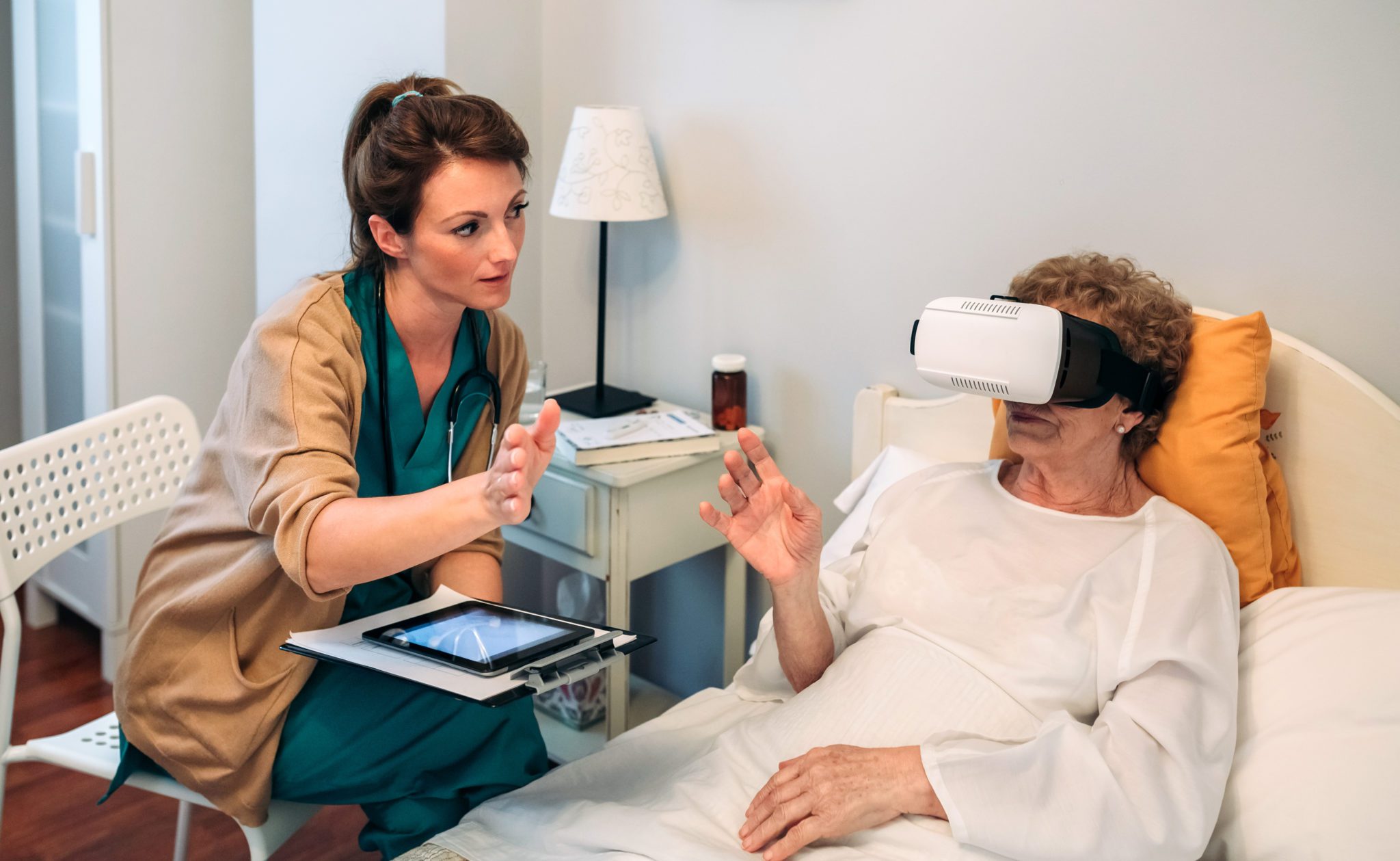With modern technology at our fingertips, there are more opportunities than ever before to work to reduce pain and improve comfort for individuals deal with complex illness, chronic pain and functional issues related to aging.
One such option is virtual reality, an increasingly versatile type of gaming and communication system that can offer surprising benefits when used to reduce or manage pain. Here’s a look at what virtual reality therapy is and the benefits.
What Is Virtual Reality?
When you think virtual reality, the first thing that probably comes to mind is video games, and for good reason. Virtual reality has been growing in popularity and versatility in recent years, but it is most well-known for its use as a method for enhanced gameplay.
It works by immersing players entirely in computer-generated worlds, through the use of VR headsets and projectors, and allows players to explore the deepest depths of the ocean or to do battle with their favorite supervillains.
And that’s not all. Virtual reality programs have come into their own in the last decade or so, but variations of virtual reality devices have been around for more than one hundred years. And they haven’t always been used for gaming or entertainment. Even NASA utilized VR devices and programming for training decades ago.
The sensory elements of immersive VR are what make the experience so life-like. They’re also why virtual reality can be an excellent intervention for pain management and supporting useful wellness habits. Lightyear Health is here to help you explore those many benefits and how they might be useful for your patients, residents or loved ones.
Benefits of Virtual Reality for Pain Management
Virtual reality has been used for gaming, entertainment, and even mock space travel. It’s becoming an increasingly popular and useful method of pain management for home use, as well. Here are a few benefits of virtual reality when it comes to relieving pain and providing support for persons recovering in a post-acute care facility or dealing with the functional decline associated with aging.
1. It Provides a Distraction
Entertainment has long been used as a form of pain relief, especially immersive and low-impact entertainment programs like gaming or interactive activities.
One theory is that the brain is only capable of accepting a certain amount of stimuli at a time. This is reinforced by the idea that pain is actually felt in the brain, and then the information is sent outward to other parts of the body.
When the body and brain are otherwise occupied with an enjoyable task, it can reduce the feeling of pain. This has proven true in children undergoing chemotherapy for cancer, who on the whole requested fewer pain medications when their pain management plan included the use of electronic video games.
Virtual reality takes the benefits of those distractions one step further.
By comprehensively replacing outside sensory input with fictional input from the game, virtual reality programming can serve as a useful distraction that reduces the feeling of pain. This can help to provide essential relief for those managing the effects of chronic or acute pain.
2. It Blocks Pain Signals From the Mind
There is evidence to indicate that virtual reality programming does more than even just distract the brain from pain and pain signaling. According to initial studies, the program can actually help to block pain signals from reaching the brain, rather than overloading them with outside stimuli.
If your brain isn’t receiving those pain signals, it isn’t sending them out to other parts of the body. Virtual reality isn’t merely masking the effects of pain or distracting your loved one from experiencing them. It actually helps to prevent those pain signals from being disseminated, stopping them at the source — think of it as pain interference through VR therapy.
3. It Reinforces Breathing Patterns
Virtual wellness programming has become a popular option for those looking to workout at home or without the use of expensive equipment. This extends to the use of meditation and breathing programs, that can reduce anxiety and support healthy breathing techniques.
Virtual reality programming taps into the existing benefits of meditation and breathing exercises used to reduce pain and anxiety surrounding pain. Deep breathing exercises can be achieved in short sessions several times a week, all with the use of a few simple virtual reality accessories.
Deep breathing is beneficial to pain management for many reasons. It can help to promote oxygen flow and support the rest that will help patients recover from and manage pain with ease. Deep breathing also helps to reduce the panic and fear associated with pain and refocuses the attention from the pain to the process of breathing.
With virtual reality programming, patients will enjoy these benefits of deep breathing, relaxation, and more. Most programs can even help to record the progress being made with regular sessions. This will help care team customize and update their pain management for more effective treatment and care.
4. It Supports a Skills-Based Treatment Program
Virtual reality programming also extends into the benefits and promotes the use of cognitive behavioral therapy, which is often used to support pain management and relief. In this specific case, skills-based treatment programs help to encourage useful pain-relieving habits through repetition and reinforcement.
There are many such programs available and made more useful through VR technology. As previously discussed, it can help to relax participants, as well as distracting them from the pain through repeated use. It can also help to encourage healthy movement, which strengthens the body and relieve immediate pain.
This can also be helpful for reducing pain intensity in the future in the same way that some physical therapy exercises can ease chronic lower back pain or knee pain by strengthening supporting muscles. Other skills-based treatments and behaviors include visualization, perspective-taking, and access to a deeper understanding of pain and its causes.
5. It Promotes Interoceptive Awareness
That deeper understanding of the causes behind pain perception and the best measurement system for them is also known as interoceptive awareness. It can be extremely useful for patients managing the effects of chronic pain to create a standard pain level scale. This will allow for doctors and care providers to properly dispense prescription medication or assign other, more effective pain management treatment options.
Interoceptive awareness can help with this process immensely. Interoceptive awareness is about understanding the internal signals your body is sending your brain, and about learning how to properly interpret them.
In addition to being able to identify when your body is in pain, this process can provide patients with a better understanding of what kind of pain it is, where it originated, and how to manage its effects.
This is part of the skills-based treatment program already essential to pain management. More benefits and increased use of interoceptive awareness can be found when adding VR sessions to a pain management plan.
6. It Reduces Anxiety Associated With Pain
In addition to the physical, it is always important to account for the emotional effects of pain, particularly long-term and chronic pain, as often experienced by older adults.
Chronic pain is often accompanied by anxiety and fear, which can actually contribute to the pain itself. Anxiety can manifest in the tightening of muscles, difficulty breathing, difficulty sleeping, and more, all of which can add to the existing pain a patient is already experiencing.
Virtual reality programming can help to reduce some of the fear associated with chronic pain, which can provide relief from said symptoms of anxiety. When patients know they have access to a low-impact but effective method of pain management, it supports them both physically and mentally and provide some feelings of relief from the general distress caused by any chronic issue.
There are many benefits to reducing anxiety when it comes to overall health and wellness, both in patients with existing chronic pain and those looking to prevent it.
7. It is Low-Impact With No Side Effects
Another reason that virtual reality can be an excellent tool for patients managing pain is that it has no side effects. Many of the medications that are used to mitigate or reduce feelings of pain or discomfort may come with uncomfortable side effects like nausea, dizziness, loss of appetite, and more, especially opioid-based medications.
VR can also reduce the need for regular medication in some cases, which means fewer side effects to worry about. That means it will be easier for your patients, residents or loved one to get the rest and relief they deserve, which can help to support their overall wellness in the future.
8. It Promotes Enjoyment and Self-Compassion
It’s just as important to manage emotional health and wellness as it is to manage physical pain. Long-term and chronic pain can take a toll on our emotional well-being, and VR can be very effective for reducing that toll.
Not only does it help to prevent pain signals and provide useful information to providers for pain management plans, but it also supports enjoyment and self-compassion.
That means patients will both get relief from their chronic pain and have a good time. They’ll be able to try out stories as different characters, experience new places, and engage with unique and interesting challenges. This supports the self-compassion that is an essential part of the rest and recovery journey.
Conclusion
Managing chronic pain can be difficult and overwhelming, especially for loved ones looking to support elderly parents or those dealing with complex illness and chronic pain. The good news is that there are increasingly low-impact and high-efficacy methods for reducing pain without serious side effects or long-term complications.
One such method is virtual reality, a reimagining of video game technology for encouraging deep breathing, reducing pain signals, supporting interoceptive awareness, and just providing a distraction from the physical here-and-now world. Virtual reality has many physical, mental, and emotional benefits for those experiencing pain, and there are practically no side effects to consider aside from the possibility of occasional motion sickness in a very small patient population.
If you’re looking to introduce innovative, science-backed treatment methods into your patients, residents or loved one’s pain management plan, Lightyear Health is here to help. We want to share cutting-edge technology and methods with families caring for older parents or loved ones, to create a plan that really works.
Learn more about how our teams of experts can help here.
Sources
The Complete Guide to Virtual Reality: Everything You Need to Get Started | The Guardian
FDA Authorizes Marketing of Virtual Reality System for Chronic Pain Reduction | FDA



